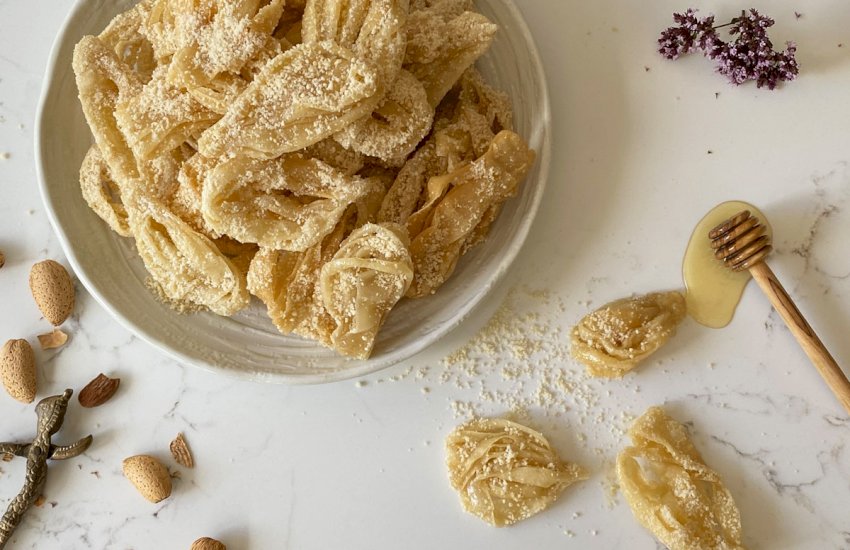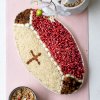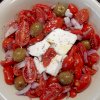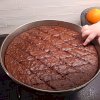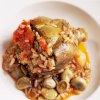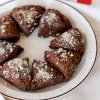Maria’s Platseda
Our beautiful guest Maria is from the village of Kalloni, on the island of Lesvos. As well as being an accomplished cook, Maria is also a great storyteller. When Maria first shared the Platseda recipe with us, she also shared a lovely story about bartering for orange blossom essence; an essential ingredient in the Platseda glaze. Growing up in my village of Kalloni, we had two monasteries; one of which was inhabited by nuns. I have special memories of my sisters and I walking along paths lined by wild lavender and oregano, to reach the nuns’ monastery. The nuns were very skilled. They weaved and embroidered beautiful cloths. They kept bees and gathered honey and they also collected sour orange blossoms, which they pressed to extract orange blossom essence. My sisters and I would offer the nuns a bottle of olive oil or some dried beans or lentils and in return they would give us a bottle of their aromatic orange blossom essence. We used this precious essence to make Platseda as a New Year’s treat. Maria’s Platseda are truly a texture and taste sensation – they are crisp, sweet, nutty and the orange blossom essence makes them intoxicatingly aromatic. Make it your New Year’s resolution to master this recipe and along the way, you may even relive the magic of childhood in the village of Kalloni, in times past.
Ingredients
For the Platsedas
2 cups flour plain
1 tablespoon olive oil
1/2 teaspoon salt
1 cup warm water
plain flour for dusting
canola oil for frying
For the glaze
2 cups honey
2 cups sugar caster
1 cup water
3 tablespoons orange blossom water
For the coating
300 g almonds blanched, finely ground
Preparation
Watch the full recipe video below. Subscribe to my YouTube channel by clicking the Subscribe link on the video
Make the platseda
Dissolve the salt in the warm water.
Combine the plain flour and olive oil in a mixing bowl. Slowly add the water mixture to the flour mixture, using a fork to mix the ingredients as you go. When the water and flour mixtures have combined, use your hands to work the mixture into a dough. Knead the dough in the bowl for a few minutes. Transfer the dough to a small bowl, cover it with a tea towel and allow it to rest for 10 minutes.
After 10 minutes, divide the dough into two halves and place one half aside.
Flour your work surface. Use your hands to form a round disc with the dough. Place the dough-disc on the floured work surface, lightly dust it with flour and roll it out with a long, thin rolling pin. Dust the flattened dough-disc with flour and wrap it fairly tightly around the rolling pin. Using your hands and a rolling action, gently press downwards and outwards on the dough to stretch it out. Unravel the fillo sheet from the rolling pin and rotate the fillo sheet 90 degrees on the work surface. Lightly dust the fillo sheet with flour, wrap it tightly around the rolling pin again and use your hands and a rolling action, to gently press downwards and outwards on the dough to stretch it out once more. Repeat this process until the fillo sheet is quite large, approximately 60 – 70cm in diameter.
Cut the fillo sheet into strips, approximately 10-12cm wide. Cut each strip into 10-12cm lengths to form square/ rectangular fillo pieces. Pick up one fillo piece and gently stretch it out, both widthways and lengthways, with your hands. Place the fillo piece back on the work surface and score it widthways 5 times, with approximately 1.5cm between each score, without cutting to the ends. Scrunch up the ends with your fingers. Pick up each end and stretch and shake the fillo piece a little, before folding it over itself and pinching the two scrunched ends together. Place the platseda aside. Repeat for the remaining fillo pieces.
Repeat the whole process for the other half of the dough.
Fry the platseda
Half fill a small baking dish or pot with canola oil and heat it on a medium to high flame. Once the oil is hot and ready for frying, pick up a platseda from the pinched end and gently lower it into the hot oil. Use a fork to gently agitate and loosen the platseda pastry ribbons. Repeat until the baking dish is half full with platseda. When one side has cooked, carefully turn the platseda over.
Fry the platseda until their colour just turns from white to cream and the fillo forms little bubbles on it. The platseda are ready when you press a fork against them and they feel firm. When ready, transfer the platseda to a colander to drain. Repeat until all of the platseda have been fried.
Glaze the platseda
Combine and mix the honey, sugar, water and orange blossom water in a medium-sized pot. Place the pot on a high flame and heat for 5-10 minutes until it comes to a boil. Skim off any scum that forms at the top of the mixture. Reduce the syrup to a simmer.
Carefully place a few platseda in the syrup and soak them for about 30 seconds, turning them over to coat both sides. Remove the platseda and place them aside. Repeat until all of the platseda have been glazed.
Coat the platseda
Place the glazed platseda in the almond meal, coating one side and then the other, and sprinkling some of the almond meal on the harder to reach spots, with your fingers.
Serve the platseda
Once coated with almond meal, platseda are ready to serve and enjoy! Recipe makes approximately 50 pieces

